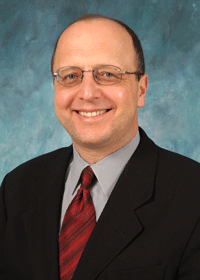 |
The results of the study were reported in the April 10 edition of the New England Journal of Medicine. The study is called SAPPHIRE, which is an acronym for “Stenting and Angioplasty with Protection in Patients at High Risk for Endarterectomy.”
The study marked the second landmark report produced by the SAPPHIRE research group over the past five years. The previous publication, also published in the New England Journal in 2004, compared stenting and surgery results at one month and one year. The current study looked at patients at three years and represents the first such long-term comparison of the procedures in this situation.
“This study – like the previous study – demonstrates that stenting is just as effective at opening the carotid artery and as safe as surgery for patients at high-risk for surgery,” said Dr. Fayad, the Reynolds Centennial Professor and chairman of UNMC’s Department of Neurological Sciences. “We now know that three years out the outcomes are almost identical. I think this will be reassuring to people, as it reaffirms that both options are equally effective.”
In the SAPPHIRE study, a total of 334 patients from 29 different centers were randomly assigned to a study group, with 167 of the patients having had the endarterectomy surgery and the other 167 patients the stenting procedure. After three years, follow-up data was available for 260 patients. Both treatment arms had equal risk of death, stroke and myocardial infarctions without a significant difference in the recurrence of the narrowing or the need to perform another intervention to relieve it.
Many blockages in the carotid artery are treated with the carotid endarterectomy procedure in which the plaque buildup is surgically removed through an incision in the neck. In carotid stenting, a balloon-tipped catheter is threaded into the artery in the groin, and once it reaches the carotid narrowing, the balloon is inflated to push back the plaque and a mesh tube, called a stent, is inserted to keep the artery open.
Surgery and traditional stenting carry risks of creating blood clots or dislodging particles from the fatty deposits they are trying to clear. When such debris is unleashed, it can travel to the brain and cause strokes, Dr. Fayad said. To reduce that risk during surgery, the artery is clamped while the atherosclerotic plaque is cut out. Stenting is done without stopping blood flow, through the use of a filtering device that is deployed in front of the stent to capture any such debris.
Trials of carotid endarterectomy done in the late 1980s and early 1990s showed that surgery was extremely helpful for some patients, but it excluded patients at high risk of surgery, Dr. Fayad said. Patients at high risk of surgery include those with severe heart disease; those who have narrowing from radiation therapy or blockage of the arteries in the neck that are difficult to reach surgically; and those who already had a carotid endarterectomy and the blockage has returned.
“The publication of our team’s results in the New England Journal of Medicine is a validation to the quality of the design and execution of the study and to the relevance of this data to physicians and patients,” Dr. Fayad said. “For a study to appear in the NEJM, you know the quality of the data is outstanding and that tremendous scrutiny has taken place to assure that accurate information is being presented to the medical community.”
The current SAPPHIRE publication was written by 12 authors, representing some of the most prestigious research institutions in the country including Harvard Medical School, the University of Michigan School of Medicine and the University of Pennsylvania School of Medicine.
“I have been honored to be involved in the SAPPHIRE study,” Dr. Fayad said. “It has been a landmark study which has given us a much better understanding of treatment options for patients with blockage in their carotid arteries.”
This paper marks the fourth time that Dr. Fayad has had an article published in the New England Journal of Medicine.
He cautioned that the results from this latest study apply to only patients at high-risk for surgery. Other ongoing studies will help answer questions related to the effectiveness and safety of surgery and stenting with patients who are not considered high-risk.
UNMC and its hospital partner, The Nebraska Medical Center, provide both the stenting procedure and the surgical procedure for patients with narrowed carotid arteries.